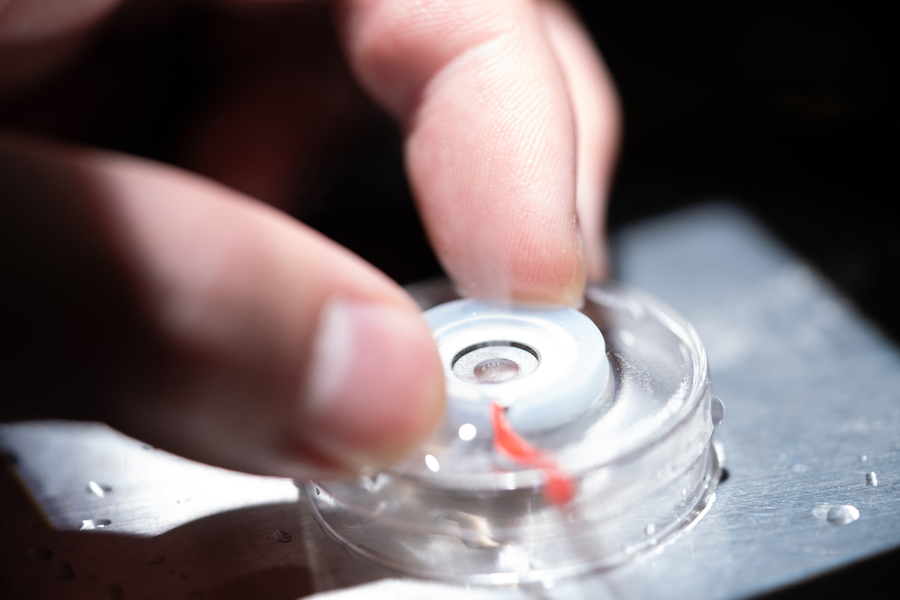2024-04-23 マサチューセッツ工科大学(MIT)
 Caption:Researchers at MIT have discovered a new phenomenon: that light can cause evaporation of water from its surface without the need for heat. Pictured is a lab device designed to measure the “photomolecular effect,” using laser beams.
Caption:Researchers at MIT have discovered a new phenomenon: that light can cause evaporation of water from its surface without the need for heat. Pictured is a lab device designed to measure the “photomolecular effect,” using laser beams.
Credits:Photo: Bryce Vickmark
<関連情報>
- https://news.mit.edu/2024/how-light-can-vaporize-water-without-heat-0423
- https://www.pnas.org/doi/10.1073/pnas.2320844121
- https://www.pnas.org/doi/abs/10.1073/pnas.2312751120
光分子効果 可視光と空気-水界面の相互作用 Photomolecular effect: Visible light interaction with air–water interface
Guangxin Lv, Yaodong Tu, James H. Zhang, and Gang Chen
Proceedings of the National Academy of Sciences Published:April 23, 2024
DOI:https://doi.org/10.1073/pnas.2320844121
Significance
We use 14 different experiments to demonstrate the existence of the photomolecular effect: photons in the visible spectrum cleave off water clusters from air–water interfaces. We use laser to study single air–water interfaces and show polarization, angle of incidence, and wavelength dependent responses, peaking at green where bulk water does not absorb. Raman and infrared absorption spectra and temperature distribution in air show the existence of water clusters under light. We suggest the photomolecular effect provides a mechanism to resolve the long-standing puzzle of larger measured solar absorptance of clouds than theoretical predictions based on bulk water optical constants and demonstrate that visible light can heat up clouds. Our work suggests that photomolecular evaporation is prevalent in nature.
Abstract
Although water is almost transparent to visible light, we demonstrate that the air–water interface interacts strongly with visible light via what we hypothesize as the photomolecular effect. In this effect, transverse-magnetic polarized photons cleave off water clusters from the air–water interface. We use 14 different experiments to demonstrate the existence of this effect and its dependence on the wavelength, incident angle, and polarization of visible light. We further demonstrate that visible light heats up thin fogs, suggesting that this process can impact weather, climate, and the earth’s water cycle and that it provides a mechanism to resolve the long-standing puzzle of larger measured clouds absorption to solar radiation than theory could predict based on bulk water optical constants. Our study suggests that the photomolecular effect should happen widely in nature, from clouds to fogs, ocean to soil surfaces, and plant transpiration and can also lead to applications in energy and clean water.
熱的限界を超える水の蒸発をもたらす光分子効果の可能性 Plausible photomolecular effect leading to water evaporation exceeding the thermal limit
Yaodong Tu, Jiawei Zhou, Shaoting Lin, +2, and Gang Chen
Proceedings of the National Academy of Sciences Published:October 30, 2023
DOI:https://doi.org/10.1073/pnas.2312751120
Significance
Water evaporation under sunlight is a pervasive phenomenon, having both fundamental and practical importance in science and technology. Solar-driven evaporation rates using porous absorbers have been reported to exceed the theoretical thermal evaporation limit, but the mechanism of this phenomenon remains unclear. Here, we hypothesize that a photon can cleave off water clusters from water–vapor interfaces and call this process the photomolecular effect, in analogy to the well-known photoelectric effect. We provide experimental evidence and explain the physical driving force supporting this hypothesis. Such photomolecular evaporation process could be happening widely in nature. It may significantly impact the earth’s water cycle, climate change, and has potential clean water and energy technology applications.
Abstract
We report in this work several unexpected experimental observations on evaporation from hydrogels under visible light illumination. 1) Partially wetted hydrogels become absorbing in the visible spectral range, where the absorption by both the water and the hydrogel materials is negligible. 2) Illumination of hydrogel under solar or visible-spectrum light-emitting diode leads to evaporation rates exceeding the thermal evaporation limit, even in hydrogels without additional absorbers. 3) The evaporation rates are wavelength dependent, peaking at 520 nm. 4) Temperature of the vapor phase becomes cooler under light illumination and shows a flat region due to breaking-up of the clusters that saturates air. And 5) vapor phase transmission spectra under light show new features and peak shifts. We interpret these observations by introducing the hypothesis that photons in the visible spectrum can cleave water clusters off surfaces due to large electrical field gradients and quadrupole force on molecular clusters. We call the light-induced evaporation process the photomolecular effect. The photomolecular evaporation might be happening widely in nature, potentially impacting climate and plants’ growth, and can be exploited for clean water and energy technologies.



